That is different, it is the modulation pattern being set by 11-02. Parameter 11-01 sets frequency, and 11-04 sets or disables a frequency reduction if the drive gets hot, which might be a good idea.
You could set the frequency to high enough that you do not hear it as a problem (maybe 8 kHz if you have typical hearing loss) and then enable the frequency reduction at high temps. The modulation pattern would depend on what you need, since it affects motor torque (and also noise).
The modulation pattern is really setting how many IGBTs are on at one time. More is more dissipation and less noise, but less is less torque. The dissipation reduction is by the average current per IGBT over time (since fewer are on at a time), and by having 1/3 fewer turn-on and turn-off events.
Techie details:
Dissipation in IGBTs comes from three main sources... Turn on/off losses, conduction losses, and "tail current" which is really part of turn-off losses.
When not conducting, the IGBT has a high voltage across it, but only a tiny leakage current flowing, so volts x amps is low, and there is nearly zero dissipation.
During turn-on, the IGBT has to change from high voltage across it but no current, to lots of current but very low voltage across it. During that time taken to change from one mode to the other, it is operating in "linear" mode, meaning that it has substantial voltage across it and current flowing through it, so dissipation is higher, volts x amps is a bigger (but changing) number. You control this by the control voltage input, the faster you change that, the less dissipation (and the more electrical and radio noise).
When it is conducting full current, it has (should have) a low voltage across it, even though it has maximum current, so volts x amps is again low. The designer of the VFD has little control of this other than by assuring full control voltage, and choosing the best device type to use.
Turn-off is like turn-on, except it is commonly slower, so dissipation is higher.
The "tail current" is unique to IGBTs (Mosfets do not have it). IGBTs conduct with two types of "charge carriers", electrons, and "holes", which are where there IS NO electron, but there is a place for one. Both can move (in opposite directions) to conduct current. After the device has been "turned off" (the control signal has been totally removed), those two types need to "recombine" in order to totally shut off current. Until they do, there is a low current still flowing, which is a significant contributor to dissipation. The manufacturers have really cut down on that by various means, the designer has little control over this aside from carrier frequency.



